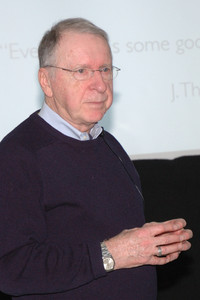Bridging the Gap: Listening to People You Don’t Want to Hear
 This session was focused on learning how to identify and overcome the gaps between different points of view in public and private discourse. It was facilitated by Dr. Grant Tate, CEO/Managing Partner of the bridge ltd, a Charlottesville consulting company that helps leaders make difficult decisions. He is the founder of three small companies and was co-founder of the New Mexico Technical Innovation Center and the Connecticut Venture Center, organizations formed to help formulate and grow entrepreneurial companies. Before starting the bridge ltd, Grant was an executive at IBM where he led a software development lab, introduced new products and managed reorganization of a hi-tech division.
This session was focused on learning how to identify and overcome the gaps between different points of view in public and private discourse. It was facilitated by Dr. Grant Tate, CEO/Managing Partner of the bridge ltd, a Charlottesville consulting company that helps leaders make difficult decisions. He is the founder of three small companies and was co-founder of the New Mexico Technical Innovation Center and the Connecticut Venture Center, organizations formed to help formulate and grow entrepreneurial companies. Before starting the bridge ltd, Grant was an executive at IBM where he led a software development lab, introduced new products and managed reorganization of a hi-tech division.
Dr. Tate spoke at the Wednesday, January 14, 2015 meeting of the Senior Statesmen of Virginia. The program was moderated by SSV Board Member Terry Cooper. A podcast of the session follows.
[display_podcast]
Program Summary
Grant Tate was introduced by SSV board member Terry Cooper who likened Mr. Tate’s organizational interventions to one who tunes up an automobile. But sometimes more than just a tune-up is required. Mr. Tate began by observing that if the car hardly runs, then he gets involved in “turnaround,” which is what we have to do with the people and the organization to really turn this into an organization.
One of the things that has struck him over the years on conflict resolution is how sparsely held are the skills of debate—people get mad and they’ll run away. Don’t turn your back. What can we do as individuals to help bridge the gap. Take the risk to trust the other people, and ask everyone in the group to take that risk and then you can begin to build trust in the organization. We all have our individual filters that will affect how we hear and see things and how we respond.
First there is a stimulus—something we hear or see. Next is our own interpretation. Then an emotional response followed by a behavioral choice leading to actions and finally consequences. Slow down and test your assumptions. One filter is attitude—habits of thought. Prejudice is an example of a fast response. One way to change the attitude is to change the messages. Persons are imbued with the attitude that they “can’t do it” due to the messages they hear throughout their lives. Education, training and how you communicate across different groups has a profound effect. One of the things he does in working to build organizations is to try to look at the person’s background.
